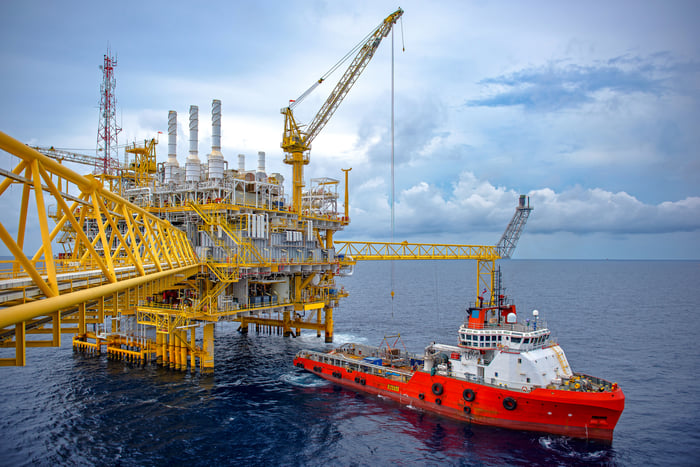It is difficult to avoid the lure of high yields. And that's precisely the reason why many investors fall for it, despite the risks involved. That doesn't mean that high-yield stocks should be completely avoided. However, it's important to know the risks involved and make an informed decision.
Three stocks -- Energy Transfer Partners (ET -1.57%), MPLX (MPLX -0.27%), and Targa Resources (TRGP 0.69%) -- are trading at yields higher than 9%. Though all the three are midstream energy stocks, two are MLPs while one is a C corp. Energy Transfer and MPLX are also much bigger in terms of market capitalization compared to Targa Resources.
Energy Transfer
Looking solely at Energy Transfer's operational performance, it's difficult to figure out why the stock trades at such a high yield and cheap valuation. It has growing cash flows and a strong cover for its distributions. Energy Transfer's solid operational performance and growth projects are enough to let it continue its massive distribution payouts in the future.

Image source: Getty Images.
However, (you knew this was coming) the company presents two major concerns: lack of trust and aggressive financial practices. Long-time investors know the company's complex history and its backdoor distribution cuts. Sunoco Logistics Partners and Energy Transfer Partners unitholders faced effective distribution cuts, even when the GP -- Energy Transfer Equity -- didn't. With such a track record, it's difficult for investors to believe that the company will not cut payouts, if needed, in future. Again, as in the past, this could be an indirect cut -- as part of a conversion to C corp or any similar way.
Investors' second concern is Energy Transfer's aggressive use of debt to grow. Admittedly, the company has taken steps to bring down its leverage. But, acquisitions such as that of SemGroup do more harm to sentiments than to the balance sheet. Energy Transfer's debt-to-EBITDA ratio is slightly higher than the 4.5% to 5% range it is targeting.
ET Dividend Yield data by YCharts
Energy Transfer has successfully executed several controversial yet key projects including the Dakota Access Pipeline and Rover pipeline. Its strong operational performance gets overshadowed by its weak governance practices. The risks, though not immediate, are real. Considering the level of investors' interest in MLPs, Energy Transfer may face a tough time while it hopes to get a boost in its stock price. Conservative investors would do better by looking elsewhere to find attractive opportunities with lower risks.
Uncertainty weighing MPLX down?
Unlike Energy Transfer, MPLX can boast a strong track record of growing distributions and a conservative leverage. The MLP has increased its distributions every quarter since its inception in 2012. MPLX recently posted strong fourth-quarter results.
But, of course, there is a caveat. A significant chunk of MPLX's revenues come from its parent company -- Marathon Petroleum (MPC -0.04%). For example, in 2018, MPLX generated 92% of its logistics and storage revenue from MPC. Marathon Petroleum is doing a strategic review of its midstream operations, which includes MPLX. With investors' interest in MLPs dwindling, the vehicle is no longer as attractive as it originally was for most parent companies. This resulted in many parent companies rolling back their MLP subsidiaries.
The outcome of MPC's strategic review is likely to be more in favor of the parent's shareholders rather than that of MPLX's. Even if MPLX remains a separate entity, there could be actions -- such as transferring back certain drop-down assets to the parent -- which may hamper MPLX's future growth. This uncertainty, along with broader sector headwinds, is likely weighing down MPLX stock. I would rather wait for the outcome of the review, which is expected to come in the first quarter itself, before taking a position in this stock.
Targa Resources: Turning the corner?
Targa Resources is barely managing to cover its high dividends for the last several quarters. The company can be credited for its success in maintaining them so far. But it did not have much success growing earnings enough to build a cushion for its payouts.
Recently completed key projects, including the Grand Prix pipeline, added to the company's fourth-quarter earnings. These projects will contribute to the company's earnings in 2020, which Targa expects will rise by around 18% over 2019.
So, even though the company's growth has been slow, it should only improve in the coming quarters. Along with an expected reduction in capital expenditures, the company should not have an issue maintaining its payout. A C corp structure may appeal a broader investor base, when the energy market conditions improve.
Targa's total consolidated debt rose from $6.7 billion at the end of 2018 to $7.8 billion at the end of 2019. The increase in debt can largely be attributed to the investments in growth projects, which the company intends to reduce in 2020. Targa Resources seems to be on the right path, which should be reflected in its stock price. On the other hand, challenging market conditions may keep both the earnings and the stock's price capped. Overall, the yield looks attractive for the risk.






